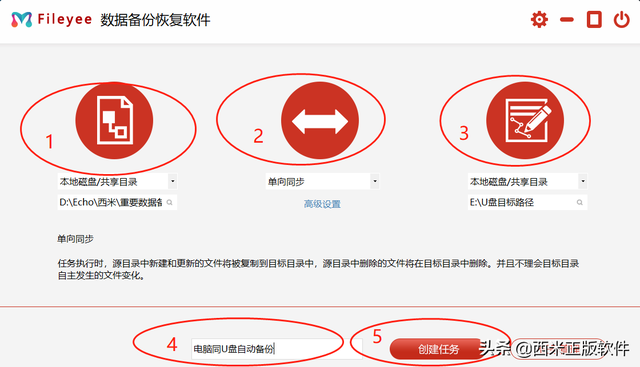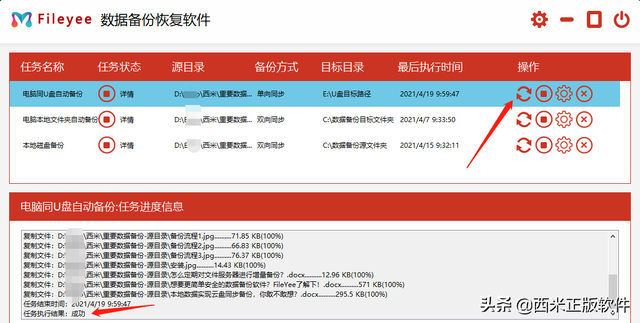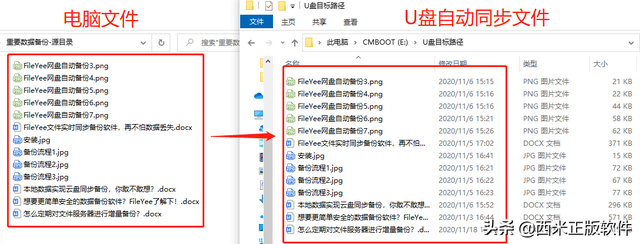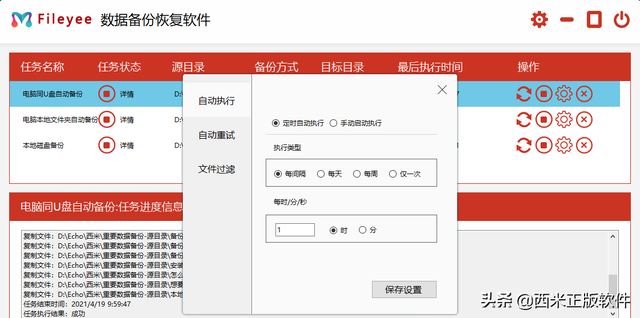Will automatically back up USB drive
php editor Apple introduces you a practical tool - software that can automatically back up a USB flash drive. This software was originally designed to solve the problem of data loss or damage when using USB flash drives. Through settings, users can easily realize automatic backup of U disk data and no longer worry about losing important files. This software is easy to operate and does not require complicated settings. Just insert a USB flash drive and it will automatically back up, making your data more secure and reliable. Both individual users and business users can benefit from it. For more detailed information about this software, please pay attention to the follow-up reports on the php Chinese website.

Preparation tools: FileYee
Basic equipment: computer, U disk
Basic work: Insert the U disk into the computer and display normally, download and install the FileYee software.
Step 1: Create a backup taskOpen FileYee and create a backup task:
①Select the local disk/shared directory, click the query button to select the backup source path, which is the folder that needs to be backed up on your computer ;
When choosing the synchronization backup method, one-way synchronization is generally selected, that is, changes in computer files will be automatically synchronized to the U disk, but changes in U disk files will not automatically update the computer files.
③Select the local disk/shared directory, click the query button to select the backup target path, which is your U disk, just select it directly;
When editing the backup task, if there is no change, the software will It automatically defaults to "My Backup Task 1", and the number increases gradually. But it is recommended that you give the task a name so that it can be easily found later, such as "Automatic backup of computer and USB flash drive."
⑤Click "Create Task".
 Step 2: Refresh to start the first backup
Step 2: Refresh to start the first backup After the task is created, return to the task management center and click "Refresh" to start the first automatic backup. Under the file backup, you can view the task progress information. After the backup is completed, "Task execution was successful." will be prompted, indicating that the backup process has been completed.

If the task fails to execute, it can be re-created, and usually it will be executed successfully. After the backup is successful, we can look at the comparison chart of the two folders:
 Step 3: Set the synchronization update frequency
Step 3: Set the synchronization update frequencyFinally set the synchronization update frequency, which is the frequency and number of updates you want, and the software will automatically The synchronized time can be accurate to seconds, so it can meet personalized needs. At the same time, you can also set "file filtering" and "automatic retry". If you don't know how to set it, you can refer to the article: Advanced settings management of FileYee data automatic backup software,

Automatic backup of entire computer files with U disk The process is completed in these three simple steps, so that automatic backup can be easily realized, saying goodbye to manual copying and pasting, which will greatly improve work efficiency. What needs to be noted here is: If the USB flash drive is pulled out of the computer, you may need to re-create the task to achieve automatic backup.
The above is the detailed content of Will automatically back up USB drive. For more information, please follow other related articles on the PHP Chinese website!

Hot AI Tools

Undresser.AI Undress
AI-powered app for creating realistic nude photos

AI Clothes Remover
Online AI tool for removing clothes from photos.

Undress AI Tool
Undress images for free

Clothoff.io
AI clothes remover

Video Face Swap
Swap faces in any video effortlessly with our completely free AI face swap tool!

Hot Article

Hot Tools

Notepad++7.3.1
Easy-to-use and free code editor

SublimeText3 Chinese version
Chinese version, very easy to use

Zend Studio 13.0.1
Powerful PHP integrated development environment

Dreamweaver CS6
Visual web development tools

SublimeText3 Mac version
God-level code editing software (SublimeText3)

Hot Topics
 1655
1655
 14
14
 1413
1413
 52
52
 1306
1306
 25
25
 1252
1252
 29
29
 1226
1226
 24
24
 How to update the image of docker
Apr 15, 2025 pm 12:03 PM
How to update the image of docker
Apr 15, 2025 pm 12:03 PM
The steps to update a Docker image are as follows: Pull the latest image tag New image Delete the old image for a specific tag (optional) Restart the container (if needed)
 Summary of phpmyadmin vulnerabilities
Apr 10, 2025 pm 10:24 PM
Summary of phpmyadmin vulnerabilities
Apr 10, 2025 pm 10:24 PM
The key to PHPMyAdmin security defense strategy is: 1. Use the latest version of PHPMyAdmin and regularly update PHP and MySQL; 2. Strictly control access rights, use .htaccess or web server access control; 3. Enable strong password and two-factor authentication; 4. Back up the database regularly; 5. Carefully check the configuration files to avoid exposing sensitive information; 6. Use Web Application Firewall (WAF); 7. Carry out security audits. These measures can effectively reduce the security risks caused by PHPMyAdmin due to improper configuration, over-old version or environmental security risks, and ensure the security of the database.
 How to create oracle database How to create oracle database
Apr 11, 2025 pm 02:36 PM
How to create oracle database How to create oracle database
Apr 11, 2025 pm 02:36 PM
To create an Oracle database, the common method is to use the dbca graphical tool. The steps are as follows: 1. Use the dbca tool to set the dbName to specify the database name; 2. Set sysPassword and systemPassword to strong passwords; 3. Set characterSet and nationalCharacterSet to AL32UTF8; 4. Set memorySize and tablespaceSize to adjust according to actual needs; 5. Specify the logFile path. Advanced methods are created manually using SQL commands, but are more complex and prone to errors. Pay attention to password strength, character set selection, tablespace size and memory
 What are the common misunderstandings in CentOS HDFS configuration?
Apr 14, 2025 pm 07:12 PM
What are the common misunderstandings in CentOS HDFS configuration?
Apr 14, 2025 pm 07:12 PM
Common problems and solutions for Hadoop Distributed File System (HDFS) configuration under CentOS When building a HadoopHDFS cluster on CentOS, some common misconfigurations may lead to performance degradation, data loss and even the cluster cannot start. This article summarizes these common problems and their solutions to help you avoid these pitfalls and ensure the stability and efficient operation of your HDFS cluster. Rack-aware configuration error: Problem: Rack-aware information is not configured correctly, resulting in uneven distribution of data block replicas and increasing network load. Solution: Double check the rack-aware configuration in the hdfs-site.xml file and use hdfsdfsadmin-printTopo
 What are the oracle11g database migration tools?
Apr 11, 2025 pm 03:36 PM
What are the oracle11g database migration tools?
Apr 11, 2025 pm 03:36 PM
How to choose Oracle 11g migration tool? Determine the migration target and determine the tool requirements. Mainstream tool classification: Oracle's own tools (expdp/impdp) third-party tools (GoldenGate, DataStage) cloud platform services (such as AWS, Azure) to select tools that are suitable for project size and complexity. FAQs and Debugging: Network Problems Permissions Data Consistency Issues Insufficient Space Optimization and Best Practices: Parallel Processing Data Compression Incremental Migration Test
 How to delete all data from oracle
Apr 11, 2025 pm 08:36 PM
How to delete all data from oracle
Apr 11, 2025 pm 08:36 PM
Deleting all data in Oracle requires the following steps: 1. Establish a connection; 2. Disable foreign key constraints; 3. Delete table data; 4. Submit transactions; 5. Enable foreign key constraints (optional). Be sure to back up the database before execution to prevent data loss.
 What is the impact of Redis persistence on memory?
Apr 10, 2025 pm 02:15 PM
What is the impact of Redis persistence on memory?
Apr 10, 2025 pm 02:15 PM
Redis persistence will take up extra memory, RDB temporarily increases memory usage when generating snapshots, and AOF continues to take up memory when appending logs. Influencing factors include data volume, persistence policy and Redis configuration. To mitigate the impact, you can reasonably configure RDB snapshot policies, optimize AOF configuration, upgrade hardware and monitor memory usage. Furthermore, it is crucial to find a balance between performance and data security.
 What types of files are composed of oracle databases?
Apr 11, 2025 pm 03:03 PM
What types of files are composed of oracle databases?
Apr 11, 2025 pm 03:03 PM
Oracle database file structure includes: data file: storing actual data. Control file: Record database structure information. Redo log files: record transaction operations to ensure data consistency. Parameter file: Contains database running parameters to optimize performance. Archive log file: Backup redo log file for disaster recovery.




